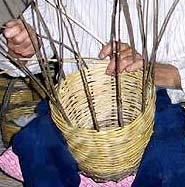The art of working canes
 This art is well developed in Gallipoli, a real secret among fishermen, who use canes for making “nasse” (bell-shaped cages used to capture fish). In Salento there are very few craftsmen of this art but few of them still work in their workshops in the old part of Gallipoli making big and small “nasse” and even souvenirs. This art is well developed in Gallipoli, a real secret among fishermen, who use canes for making “nasse” (bell-shaped cages used to capture fish). In Salento there are very few craftsmen of this art but few of them still work in their workshops in the old part of Gallipoli making big and small “nasse” and even souvenirs.
Canes are used in the dairy industry too, to make the “fiscelle”, little baskets to keep cheese and especially the “ricotta”, a soft cheese. These “fiscelle” are made following the same technique as “nasse”, but the holes are smaller, to let the liquid drop out. Another typical cheese, the “giuncata”, is produced using canes: in fact it is a very fresh cheese made out of milk that, once curdled, drains on a bundle of canes.
You will see canes also in baskets, called “panari”, used to contain olives or fruit.
|